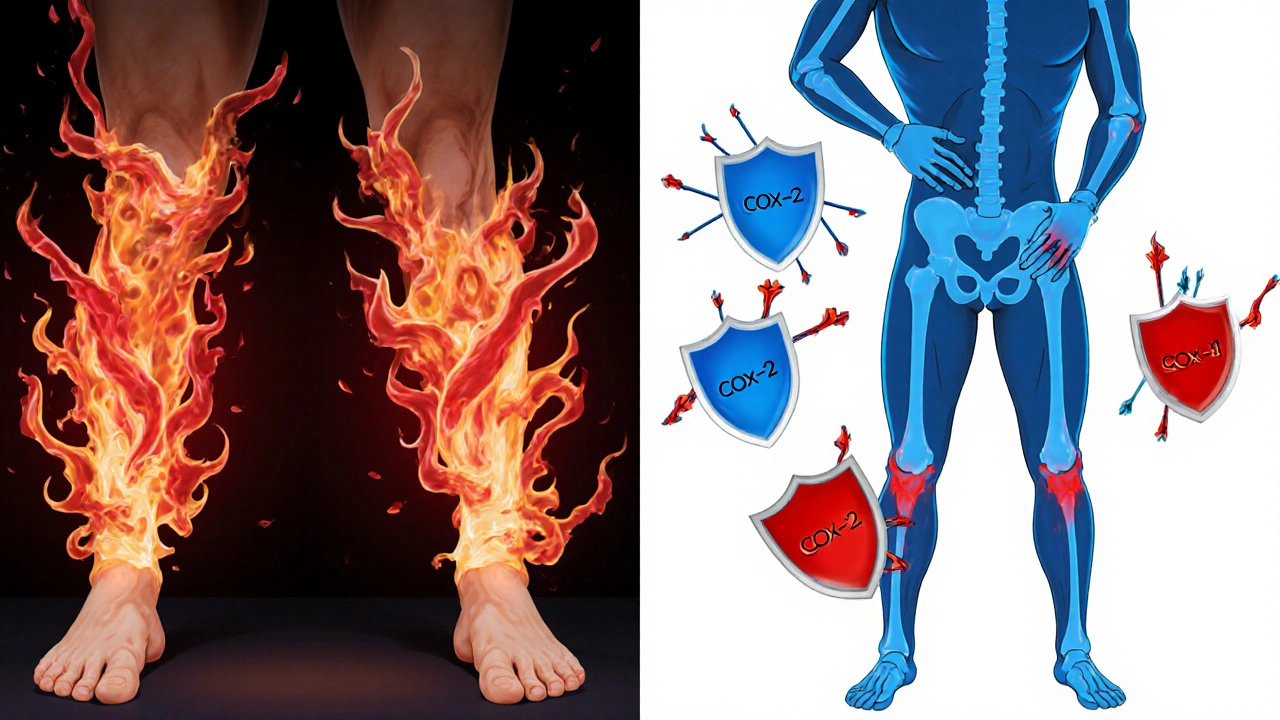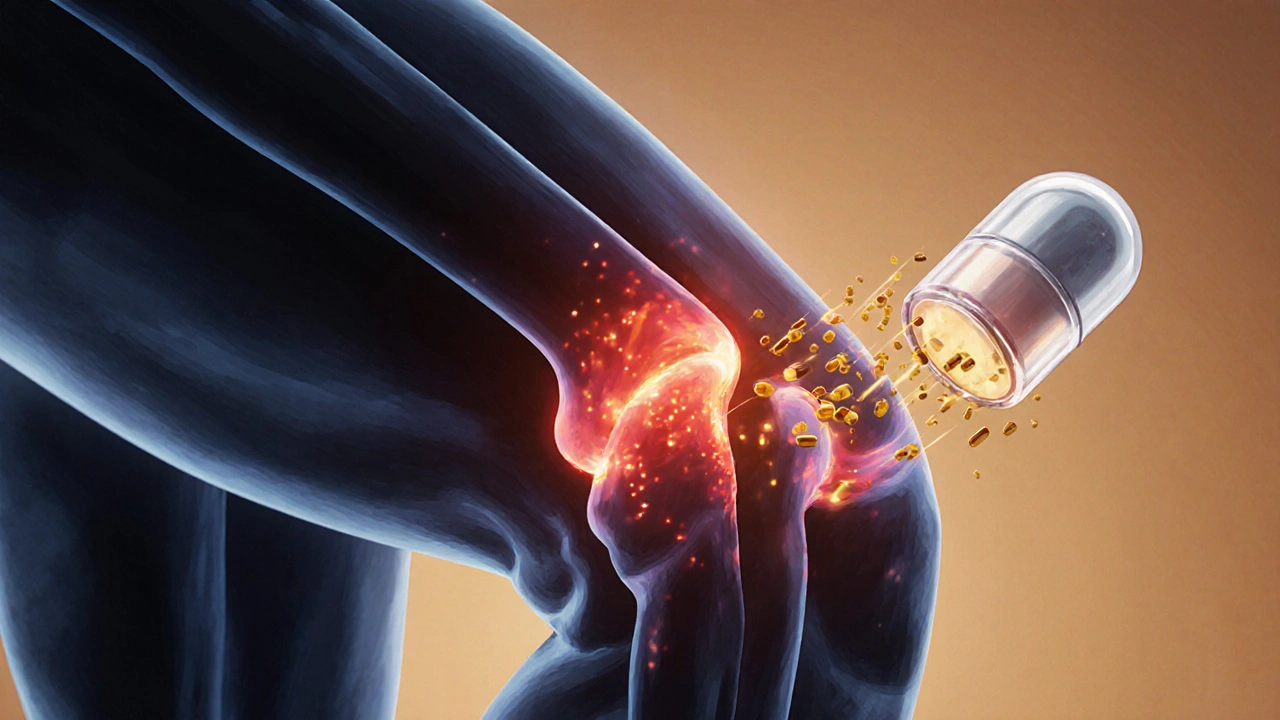Etodolac isn’t just another painkiller. If you’ve been prescribed it for arthritis, a sprain, or chronic back pain, you might wonder how something you swallow in a pill can actually calm down swelling and hurt deep inside your joints. It’s not magic. It’s chemistry. And understanding how it works gives you real power over your own treatment.
What Etodolac Actually Is
Etodolac is a nonsteroidal anti-inflammatory drug, or NSAID. That means it’s in the same family as ibuprofen, naproxen, and celecoxib. But unlike some of those, etodolac was designed to be more selective. It doesn’t just block every inflammatory signal in your body-it targets the ones that matter most for pain and swelling.
It’s been on the market since the late 1980s. The FDA approved it for osteoarthritis and rheumatoid arthritis in 1991. Since then, millions of prescriptions have been filled. It’s not the first NSAID people reach for, but it’s often chosen when others cause stomach upset or don’t last long enough.
How Inflammation Works in Your Body
To understand etodolac, you need to see what it’s fighting. When you injure your knee, tear a muscle, or develop arthritis, your body doesn’t just sit still. It sends out chemical alarms. One of the biggest players in that alarm system is a group of enzymes called COX-short for cyclooxygenase.
There are two main types: COX-1 and COX-2. COX-1 helps protect your stomach lining and keeps your blood platelets working normally. COX-2? That’s the troublemaker. It pops up where there’s injury or infection and starts making prostaglandins. These are hormone-like chemicals that cause swelling, heat, redness, and-most importantly-pain.
So inflammation isn’t bad by itself. It’s your body’s way of healing. But when it’s stuck on-like in chronic arthritis-it becomes the problem.
How Etodolac Blocks the Signal
Etodolac steps in and binds tightly to the COX-2 enzyme. Think of it like jamming a key into a lock so the real key can’t turn. When COX-2 is blocked, it can’t make prostaglandins. Less prostaglandins means less swelling. Less swelling means less pressure on nerves. And less pressure on nerves means less pain.
What makes etodolac different from older NSAIDs like aspirin or naproxen is its preference. It doesn’t ignore COX-1 entirely, but it doesn’t crush it either. Studies show it has about a 5-to-1 ratio of COX-2 to COX-1 inhibition. That’s better than ibuprofen (which is closer to 1-to-1) and not as extreme as celecoxib (which is nearly 100-to-1). This balance means you get pain relief without as much risk of stomach bleeding or ulcers.
It also lasts longer. Most NSAIDs need to be taken every 4 to 6 hours. Etodolac’s half-life is around 7 hours. That means a single 400 mg dose can keep inflammation down for up to 12 hours. Many people take it just twice a day-morning and night.
Where You’ll See Results
People using etodolac for osteoarthritis often report feeling better within 24 to 48 hours. For acute injuries like a sprained ankle, pain relief can start in as little as 30 minutes after taking the pill, though full anti-inflammatory effects take a day or two.
It’s not a cure. It doesn’t repair cartilage or reverse joint damage. But it lets you move. It lets you sleep. It lets you get out of bed without needing to stretch like you’re 80 years old (even if you are).
A 2023 study in the Journal of Clinical Rheumatology tracked 427 patients with knee osteoarthritis over 12 weeks. Those taking etodolac 400 mg twice daily showed a 47% average reduction in pain scores compared to placebo. That’s not just statistically significant-it’s life-changing.

What It Doesn’t Do
Etodolac won’t fix your spine. It won’t shrink a tumor. It won’t lower your cholesterol. And it won’t stop your immune system from attacking your own joints if you have lupus or rheumatoid arthritis-it just quiets the noise.
It also doesn’t work for everyone. About 1 in 5 people don’t respond well to etodolac. That’s normal with NSAIDs. If you’ve tried it for two weeks and feel no difference, talk to your doctor. Maybe you need a different NSAID, or maybe you need something that targets the immune system directly.
Side Effects and Risks
Like all NSAIDs, etodolac carries risks. The biggest? Stomach irritation. Even though it’s gentler than some, it still reduces protective prostaglandins in your gut. That’s why you’re told to take it with food. If you get persistent heartburn, nausea, or black stools, stop taking it and call your doctor.
Long-term use can affect your kidneys. Your kidneys rely on prostaglandins to keep blood flowing properly. If you’re dehydrated, elderly, or already have kidney disease, etodolac can make things worse. That’s why your doctor checks your blood pressure and kidney function before prescribing it.
It can also raise your risk of heart attack or stroke, especially if you already have heart disease or take it in high doses for months. That’s why it’s not recommended for people with uncontrolled hypertension or a history of heart failure.
And don’t mix it with other NSAIDs. No ibuprofen, no naproxen, no aspirin unless your doctor says so. You’re not doubling the benefit-you’re doubling the risk.
Who Should Use It
Etodolac is most often prescribed for:
- Osteoarthritis of the knees, hips, or hands
- Rheumatoid arthritis
- Acute musculoskeletal injuries (like sprains or strains)
- Chronic low back pain without nerve involvement
It’s not usually the first choice for migraines or headaches. It’s not used for fever. And it’s not safe during the third trimester of pregnancy.
People over 65, those with a history of ulcers, or anyone on blood thinners need extra monitoring. But for many, it’s a reliable, long-lasting option that doesn’t knock them out like opioids or cause the gut chaos of older NSAIDs.

How to Take It Right
Take etodolac exactly as prescribed. Standard doses are 200 mg, 300 mg, or 400 mg, one to two times a day. Never crush or chew extended-release tablets. Always swallow with a full glass of water. Eat something before you take it-bread, yogurt, a banana. Don’t lie down for at least 10 minutes after swallowing.
If you miss a dose, take it when you remember. But if it’s almost time for the next one, skip the missed one. Don’t double up.
Store it at room temperature, away from moisture. Keep it out of reach of kids and pets. A single pill can be dangerous to a small dog.
Alternatives to Consider
If etodolac doesn’t work or causes side effects, here are other options:
| Drug | COX-2 Selectivity | Dosing Frequency | Typical Daily Dose | Stomach Risk |
|---|---|---|---|---|
| Etodolac | Moderate (5:1) | Twice daily | 400-600 mg | Moderate |
| Ibuprofen | Low (1:1) | Every 6-8 hours | 1200-3200 mg | High |
| Naproxen | Low (1:1) | Twice daily | 500-1000 mg | High |
| Celecoxib | High (100:1) | Once or twice daily | 100-200 mg | Low |
| Diclofenac | Moderate (10:1) | Twice daily | 75-150 mg | High |
Celecoxib is the most selective and easiest on the stomach, but it’s more expensive and carries a higher heart risk. Naproxen is cheaper and has the lowest heart risk among NSAIDs, but it’s rougher on the gut. Etodolac sits in the middle-good balance, decent duration, manageable side effects.
What to Expect Over Time
Many people start etodolac thinking it’s a quick fix. It is-for pain. But for inflammation? That takes time. Don’t expect your swollen knuckles to shrink overnight. Give it 3 to 5 days. If you’re still stiff and sore after two weeks, talk to your doctor. Maybe you need physical therapy. Maybe you need a steroid injection. Or maybe you need to switch.
Long-term users should get blood tests every 6 to 12 months to check kidney and liver function. Your blood pressure should be monitored too. NSAIDs can sneak up on you-no warning signs until something breaks.
And never stop cold turkey if you’ve been taking it for months. Talk to your doctor about tapering. Your body adapts. Stopping suddenly can cause rebound pain or inflammation flare-ups.
Bottom Line
Etodolac works because it’s smart. It doesn’t shut down your whole body’s defense system. It just silences the loudest alarm-COX-2-so you can move without pain. It’s not perfect. It’s not risk-free. But for millions, it’s the difference between staying stuck on the couch and walking to the mailbox.
If your doctor prescribed it, they chose it for a reason. Take it right. Watch for side effects. Don’t compare your experience to someone else’s. And if it helps you live better? That’s science doing its job.
How long does it take for etodolac to start working?
Pain relief can begin within 30 to 60 minutes after taking a dose, but full anti-inflammatory effects usually take 2 to 3 days. For chronic conditions like arthritis, you may need up to a week to notice significant improvement in stiffness and swelling.
Can I take etodolac with other painkillers?
No, you should not combine etodolac with other NSAIDs like ibuprofen, naproxen, or aspirin. Doing so increases your risk of stomach bleeding, kidney damage, and heart problems without adding any extra benefit. Acetaminophen (Tylenol) is generally safe to use alongside etodolac for additional pain relief, but always check with your doctor first.
Is etodolac stronger than ibuprofen?
In terms of pain relief, etodolac is roughly equivalent to ibuprofen at standard doses. But etodolac lasts longer-up to 12 hours per dose-so you don’t need to take it as often. It also tends to be gentler on the stomach than ibuprofen because it’s more selective in targeting COX-2 enzymes.
Does etodolac cause weight gain?
Etodolac itself doesn’t directly cause weight gain. But it can lead to fluid retention, especially in people with heart or kidney issues. This may cause temporary swelling in the legs or ankles and a slight increase on the scale. If you notice sudden weight gain or swelling, contact your doctor immediately.
Can I drink alcohol while taking etodolac?
It’s best to avoid alcohol. Combining alcohol with etodolac increases your risk of stomach bleeding and liver damage. Even moderate drinking-like a glass of wine or beer-can raise these risks, especially with long-term use. If you drink regularly, talk to your doctor before starting etodolac.
Is etodolac safe for long-term use?
Etodolac can be used long-term for chronic conditions like arthritis, but only under medical supervision. Regular blood tests, blood pressure checks, and kidney function monitoring are essential. If you’ve been taking it for more than 3 months, your doctor should review whether it’s still the best option for you.
What happens if I stop taking etodolac suddenly?
Stopping etodolac abruptly won’t cause withdrawal symptoms like with opioids. But if you’ve been using it for inflammation control, your pain and swelling may return quickly-sometimes worse than before. This is called rebound inflammation. Always talk to your doctor before stopping, especially if you’ve been on it for weeks or months.


Jackson Olsen
October 28, 2025 AT 06:34Just took etodolac for my knee and wow it actually worked. Took me 20 mins to stand up and now I can walk to the fridge like a normal human. 🙌
Amanda Nicolson
October 30, 2025 AT 00:06Okay but let’s be real-etodolac is the quiet MVP of NSAIDs. I’ve been on ibuprofen for years and my stomach was basically a war zone. Switched to etodolac and suddenly I could eat tacos without fearing a midnight emergency. It’s not magic, it’s science, but honestly? Science deserves a standing ovation. I take mine at 8am and 8pm, no crashes, no weird buzz, just steady relief. My cat even notices I’m less grumpy. 🐱
Penny Clark
October 31, 2025 AT 17:02i’ve been on this for 3 months and my hands dont feel like frozen claws anymore 😭 thank you science
caiden gilbert
November 2, 2025 AT 01:47Etodolac’s like that one friend who shows up late but brings the good stuff. Not flashy, not loud, but somehow always there when you need it. No drama, just chill relief. I don’t even notice it’s working until I realize I climbed three flights of stairs without wincing. That’s the good kind of invisible magic.
Aditya Singh
November 3, 2025 AT 16:40Let me enlighten you all-this is just another COX-2 inhibitor exploiting evolutionary loopholes. The body’s inflammatory cascade is a symphony of cytokines and prostaglandins and you’re just silencing one instrument. What about the downstream epigenetic modulation? Nobody talks about that. This is surface-level pharmacology dressed up as wisdom
MOLLY SURNO
November 4, 2025 AT 20:13Thank you for the clear, well-researched breakdown. As a nurse, I appreciate when patients come in with accurate information. Etodolac’s balance of selectivity and duration is indeed underappreciated in primary care.
Niki Tiki
November 6, 2025 AT 10:33Why are we still giving out these pills like candy? Big Pharma’s got us hooked on chemicals instead of fixing the root cause-your diet, your sleep, your stress. I haven’t taken a pill in 5 years and my back’s better than ever. Just eat clean and move. Stop relying on pills to fix laziness
Jim Allen
November 8, 2025 AT 02:47So… this is just a fancy ibuprofen with a longer shelf life? Why does it cost 3x more? Are we being scammed or is this just marketing genius? I’m not mad, just confused.
Prakash pawar
November 9, 2025 AT 04:13In India we use diclofenac gel and it works better and cheaper. Why are Americans so obsessed with pills? Also etodolac is not even in our formulary. You guys overmedicate everything
Emily Kidd
November 11, 2025 AT 01:06PSA: If you’re on etodolac and start feeling dizzy or your ankles swell like balloons-STOP and call your doc. I ignored it for a week and ended up in the ER with fluid overload. It’s not common but it’s real. Listen to your body. 💙
Nate Girard
November 12, 2025 AT 00:03This is the kind of post that makes me believe in Reddit. Clear, honest, no fluff. I’ve been telling my mom about this for months. She’s 72 and finally got relief after 3 years of suffering. Thank you for writing this. You helped someone today.
John Kane
November 13, 2025 AT 13:25For anyone new to this-give it at least 5 days before deciding if it works. I thought it was useless on day 2, then on day 6 I realized I’d been walking without my cane for three days straight. I didn’t even notice I’d stopped limping. That’s the quiet win.
Katherine Reinarz
November 14, 2025 AT 02:54my doctor prescribed this and i cried because i finally felt human again. i havent slept through the night in 7 years. now i do. i dont know how to thank you
Alex Hundert
November 15, 2025 AT 17:11Just want to add-don’t mix this with alcohol. I thought one beer was fine. It wasn’t. Woke up vomiting blood. ER visit. Don’t be me.
Justin Cheah
November 16, 2025 AT 23:36Let’s be honest-this whole NSAID thing is a distraction. The real problem? The food industry. Glyphosate in your bread. Sugar in your coffee. They’re poisoning your gut lining and then selling you pills to mask the symptoms. This isn’t medicine-it’s corporate band-aids. Wake up.
Callum Breden
November 18, 2025 AT 09:46While the pharmacokinetics are technically accurate, the presentation is dangerously oversimplified. The COX-2 selectivity ratio cited is based on in vitro models with limited clinical correlation. Furthermore, the 47% pain reduction statistic lacks adjustment for placebo response in chronic pain cohorts. This is not evidence-based medicine-it’s pharmaceutical propaganda.
phenter mine
November 18, 2025 AT 17:18i took this and it worked great but i forgot to eat and got a tummy ache oops lol
Mansi Gupta
November 19, 2025 AT 03:35Thank you for sharing this. In my community, many elderly patients are afraid to take any medication. This kind of clear explanation helps them feel safe. I’ve printed it out to share at our senior center.
Jackson Olsen
November 21, 2025 AT 01:07That’s actually why I switched. My doc said the same thing-etodolac’s gentler on the gut. I used to take ibuprofen like candy. Now I just take one in the morning and one at night. Life’s easier.